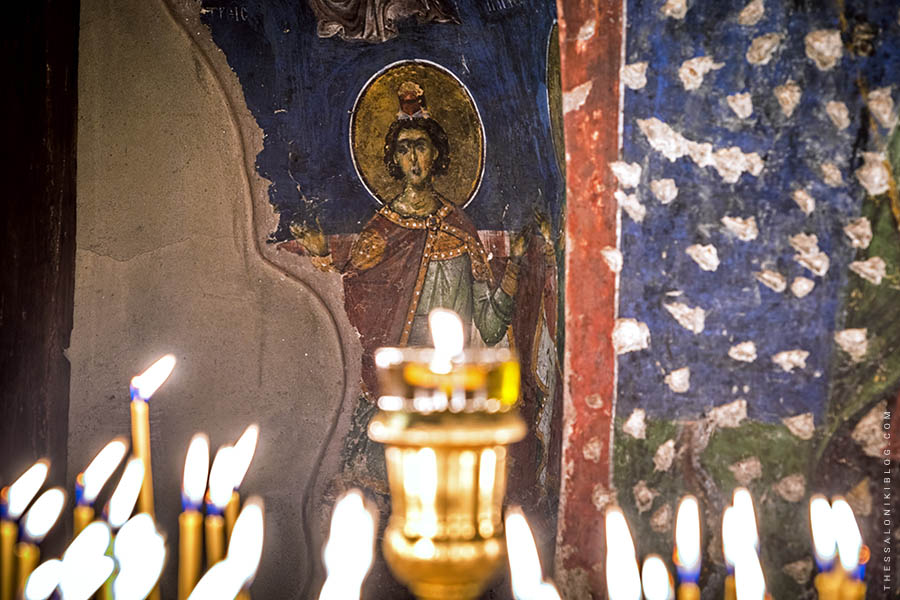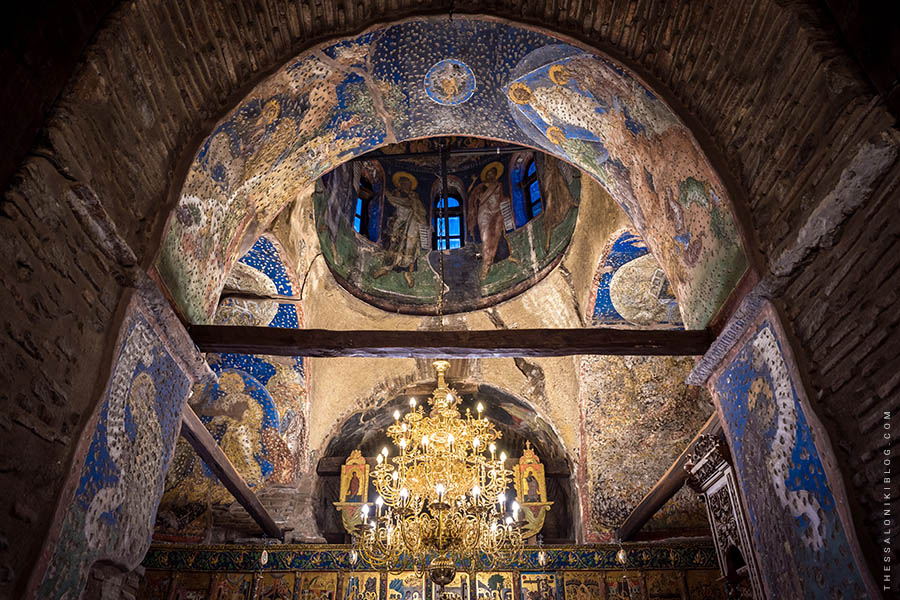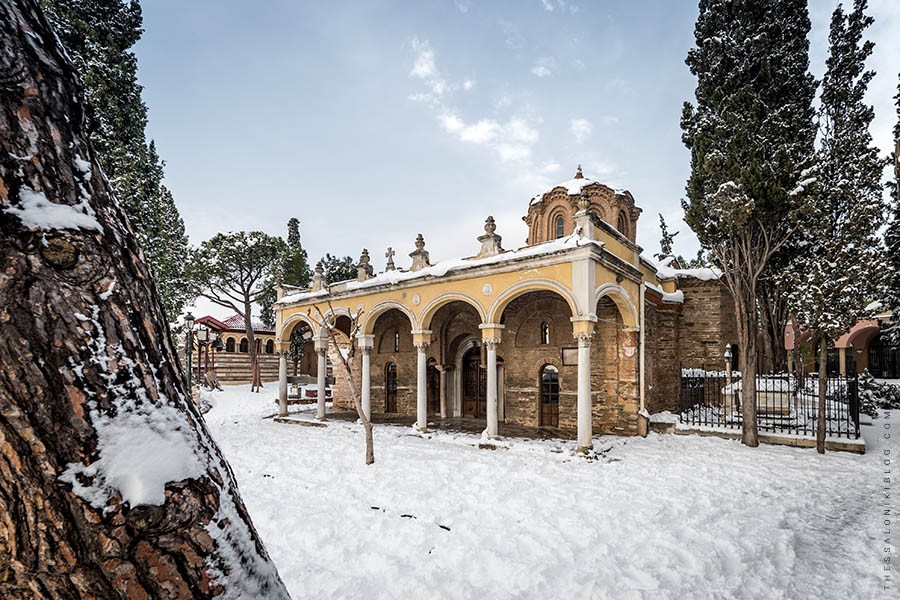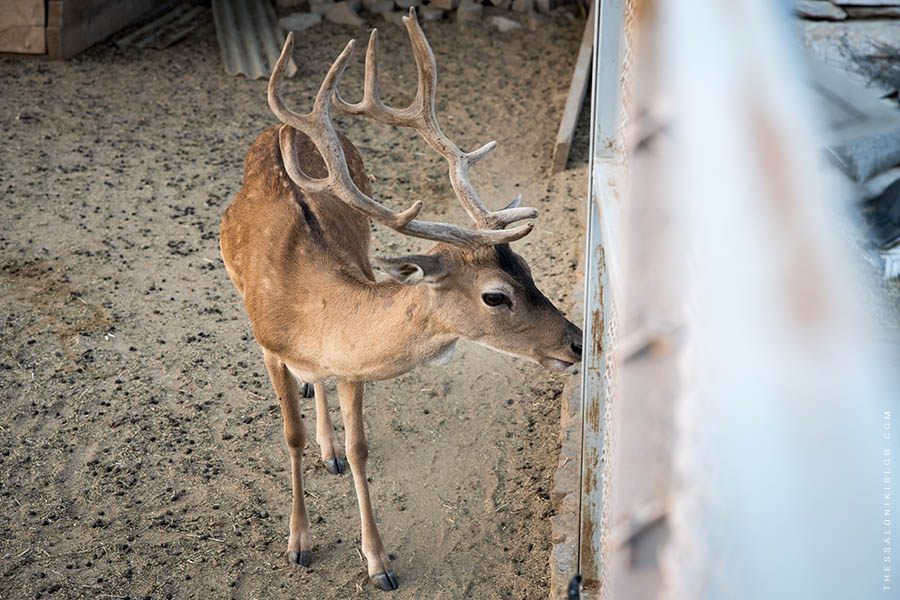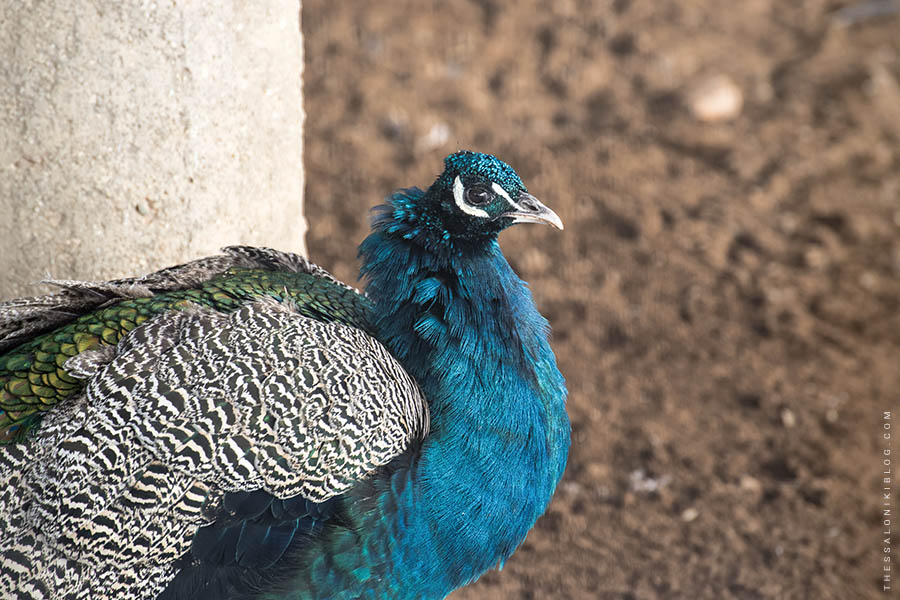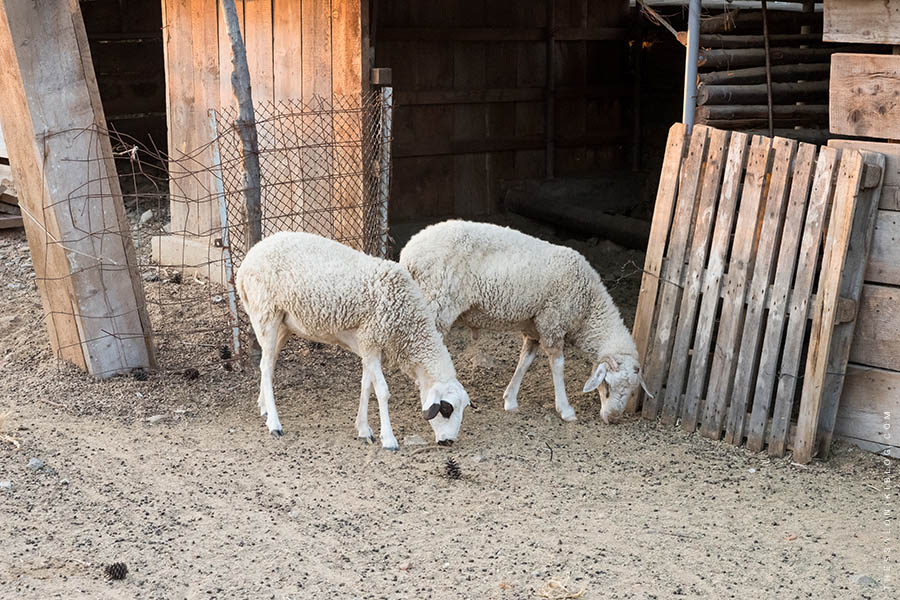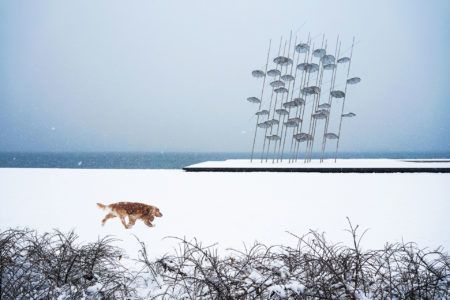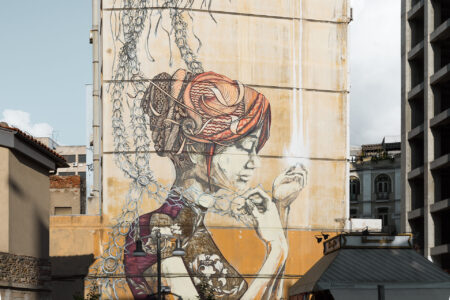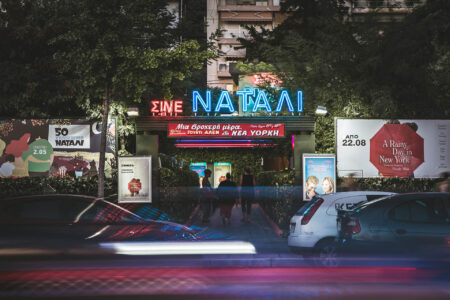VISITING THE UNESCO MONUMENTS OF THESSALONIKI
A Two-day Itinerary to the Paleochristian & Byzantine World Heritage Monuments of the City (Day 2)
The second day of our recommended itinerary to the UNESCO listings of Thessaloniki, consists of the rest eight (8) of the Paleochristian and Byzantine Monuments that are located in the Upper Town or close to its limits (see “Route B” in the map below, depicted with the blue line). If you haven’t already read the first part of the article about the other seven (7) monuments, situated in the center of the city, you can click here.
Since almost all of the Byzantine monuments on Day 2 are located on the steep streets of the Upper Town, visiting all of them on foot is going to be a little bit tiring. There is, however, the option of public transport or driving, although the latter is not going to be easy. On the other hand, if you love walking, it is a great opportunity to see the picturesque neighborhoods of the only part of the city that was saved both from the fire of 1917 and the apartment blocks of the ’60s. Also, the Byzantine churches in the Upper Town, when compared with most of those at the center of the city, are relatively small and they do not demand a lot of time to be explored in detail.
The total distance to be covered is 4.70km and the altitude difference between the starting point at the lowest elevation (church of the Holy Apostles) and the highest point (Heptapyrgion) is approximately 170m. Following the itinerary along the uphill direction is recommended because of the limited open hours of the churches during the afternoon. If, however, you have more days to dedicate for the UNESCO Monuments of Thessaloniki, starting from the Heptapyrgion is recommended.
The best day for the second part of the itinerary is Wednesday or Friday when all of the monuments on Day 2 are open. This limitation is due to the Byzantine Bath which is open only on Tuesdays, Wednesdays, and Fridays while the church of Agios Nikolaos Orfanos is closed on Tuesdays. If you cannot arrange your visit on one of these two days of the week, you will be able to see the Byzantine Bath only from the outside (or if you are lucky during an exhibition or any other cultural event, that may be hosted in the bath on the day of your visit). You can find the opening hours of all the UNESCO Monuments of Thessaloniki here.
ITINERARY MAP
Map use instructions:
Along the blue line of the map, you can see the UNESCO monuments of Thessaloniki that are included on Day 2 (“Route B”) of the itinerary. The white line represents the city walls. Click on any pin to see the name of the monument that is located on that certain spot.
For a more detailed background image, click the “Satellite” button. For better navigation in mobile phones, tap on the square button on the top right corner to get into Full-Screen mode. To get into Street View mode, use the square button on the bottom right corner (drag and drop).
You can read about the monuments of the first day of the itinerary (the orange line) here.
8) CHURCH OF AGIOI APOSTOLOI (HOLY APOSTLES)
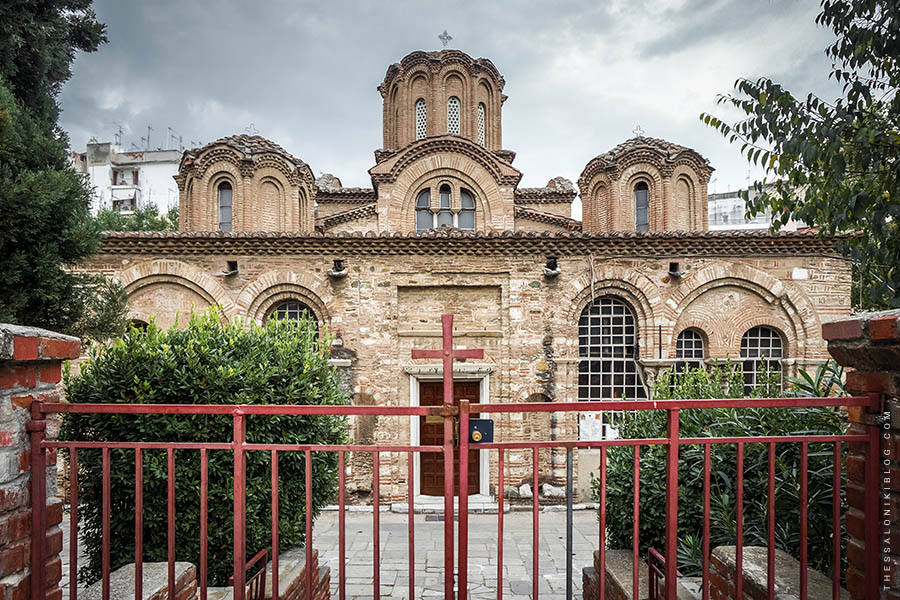
Address: 1 Olimpou Street (see on Google Maps)
Opening hours: Daily 07:30-12:00 and during the Vespers in the evening (entrance on the south side)
Admission: Free entrance
Phone number: +30 231 053 7448
Address:
1 Olimpou Street (see on Google Maps)
Opening hours:
Daily 07:30-12:00 and during the Vespers in the evening
(entrance on the side side)
Admission:
Free entrance
Phone number:
+30 231 053 7448
The church of the Holy Apostles was built in the first half of the 14th century and it was the Katholikon (the main church) of an old monastery. It is remotely located close to the west walls of Thessaloniki, in the beginning of Olimpou Street, and it is considered one of the hidden treasures of the city. Of the old monastery, and besides the Katholikon, there have been saved only the remainings of a gateway south of the building and a cistern at its north-west. The main founder of the church was the Ecumenical Patriarch of Constantinople, Nephon I (1310-1314). His name as a founder is referred to several inscriptions on the church itself, together with the name of his pupil, abbot Paul, as a second founder. The church was built under the supervision of the latter during the time that Nephon I was a Patriarch or up to two decades later.
The architecture of the Holy Apostles is based on the composite, five-domed, tetrastyle, cross-in-square type, with two chapels at the east side (left and right of the sanctuary), an ambulatory along the south, west, and north sides and a narthex at the west end. Its exterior is decorated with brick patterns, while its sculptural decoration consists of the marble capitals of the four columns that support the main dome in the nave and the capitals at the arched openings of the narthex at the west side.
What makes the church of the Holy Apostles stand out more than anything else, however, is its brilliant mosaics – probably the most beautiful in Thessaloniki – that embellish the upper parts of the nave and the main dome. They are among the last mosaics of the Byzantine empire and the last ones in Thessaloniki. In the interior of the church, besides the mosaics, there are also fine wall-paintings located on the lower walls of the nave, on the narthex, the ambulatory, the north chapel, and the sanctuary. Both the wall-paintings and the mosaics, are dated to the Palaeologan Period and are attributed to an artistic workshop from Constantinople. Although they have been saved in a fragmented condition, they are considered to be among the greatest examples of Byzantine art.
The church of the Holy Apostles was converted into a mosque in the first half of the 16th century, during which the wall-paintings were hammered, and covered with plaster. The mosaics were also covered, after the removal of their gold tesserae. The minaret, which was built close to the south-west corner of the church, has not been saved. The name “Holy Apostles” was attributed to the church in the 19th century, due to the belief that it had twelve domes symbolizing the Apostles. Initially, before its conversion into a mosque, it was probably dedicated to the Virgin.
How to get there:
The church of the Holy Apostles is the starting point of the second day of our recommended itinerary (Route B). Try to get there as early as possible so that you will have time to visit the next monuments before they are closed. It would be best to visit the church on a sunny day so that you can see the mosaics under adequate natural light. To get to the Holy Apostles by public transport, take bus 27 until “Ergatikes Katoikies” bus-stop. Then walk down on Lagada Street for 100m until the junction with Agiou Dimitriou Street and turn left. Walk on Agiou Dimitriou Street for 250m until Amazonon Street and turn right. Alternatively, take bus 26 until Kafantari bus-stop and walk down the street until you reach Agiou Dimitriou Street. Turn left and walk for 80m more until Amazonon Street. To see the exact bus routes and bus-stops, visit the web page of OASTH.
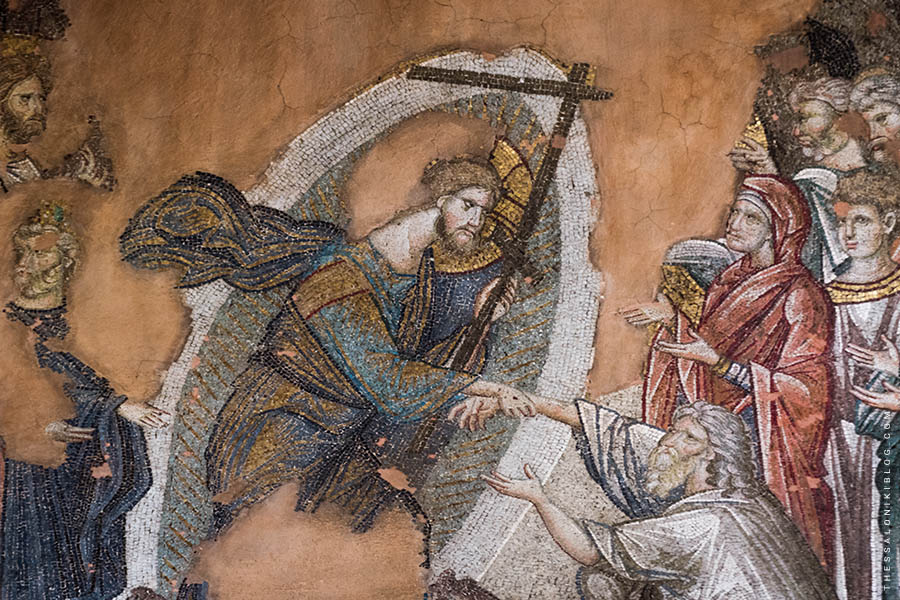
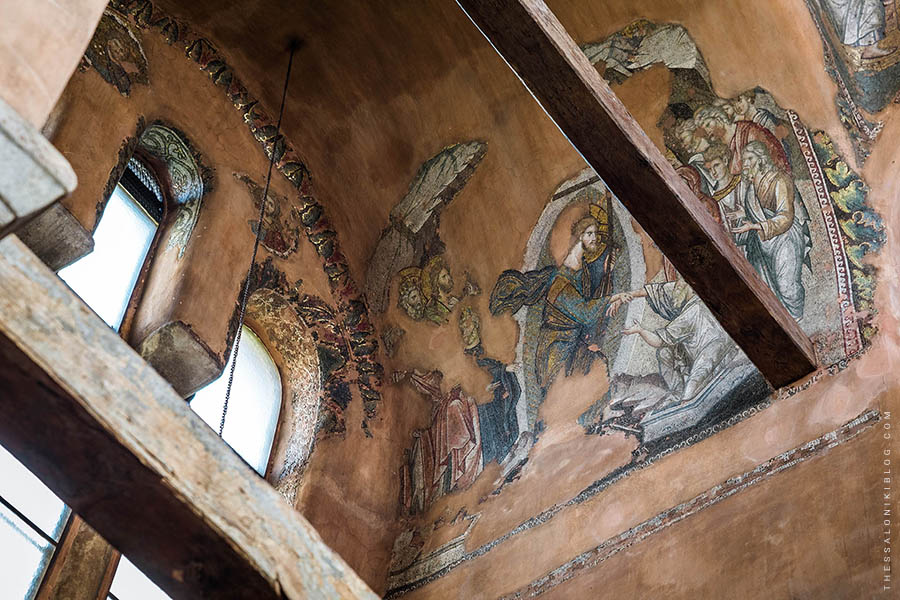
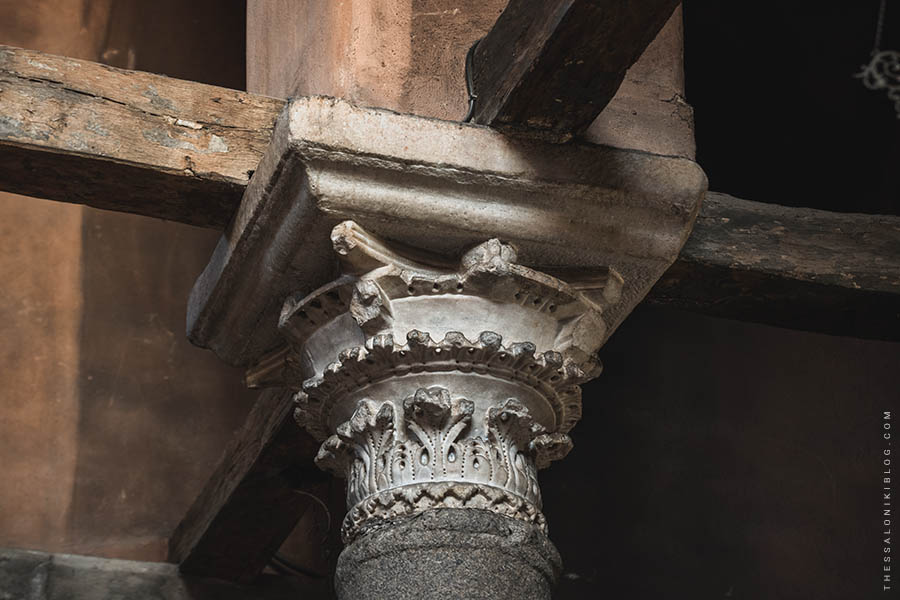
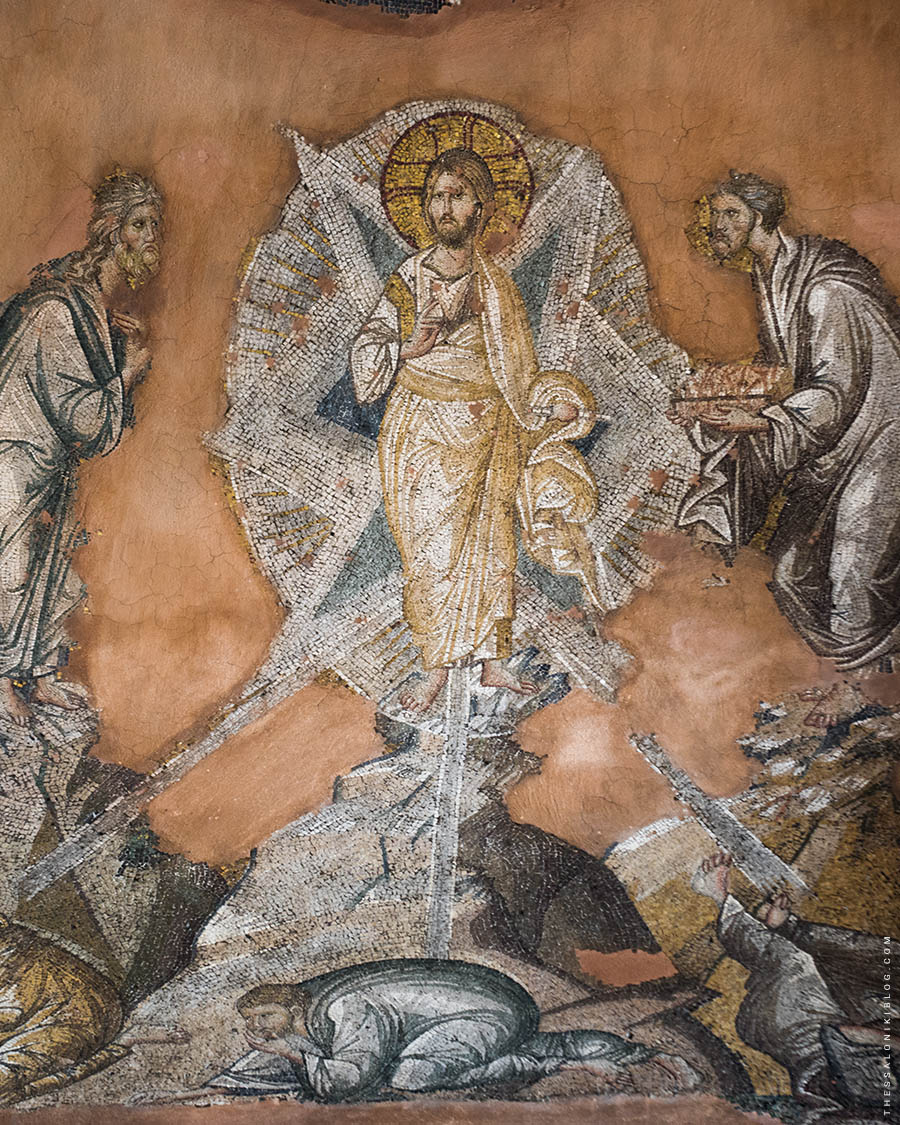
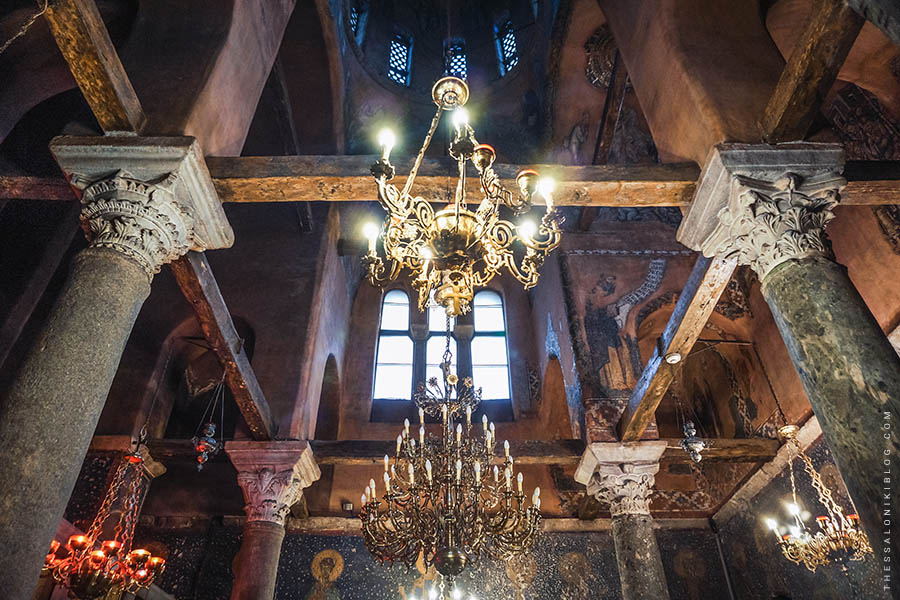
9) CHURCH OF AGIA EKATERINI (SAINT CATHERINE)
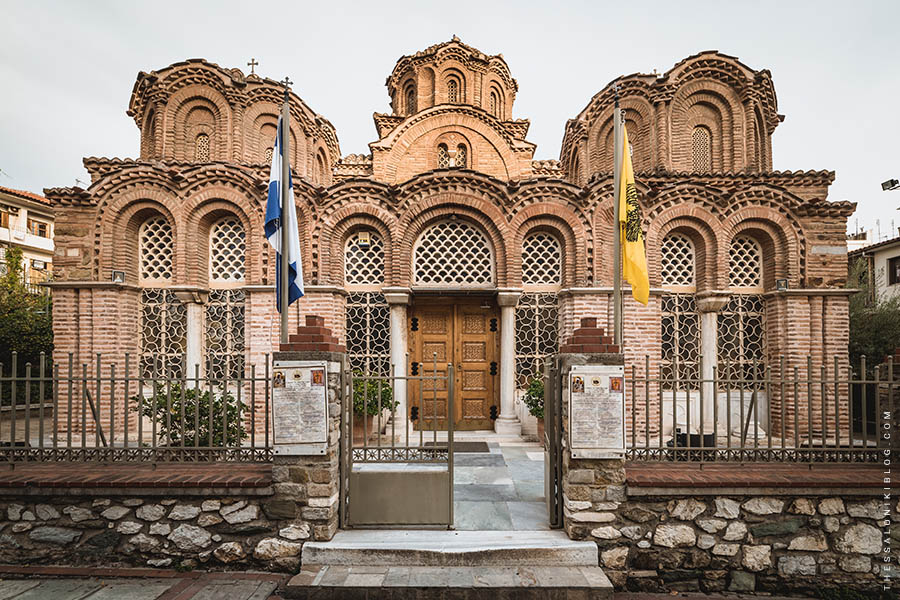
Address: Junction of Tsamadou and Ious Streets (see on Google Maps)
Opening hours: Daily 07:30-11:00 and during the Vespers in the evening
Admission: Free entrance
Phone number: +30 231 022 5580
Address:
Junction of Tsamadou and Ious Streets (see on Google Maps)
Opening hours:
Daily 07:30-11:00 and during the Vespers in the evening
Admission:
Free entrance
Phone number:
+30 231 022 5580
The church of Agia Ekaterini was built in the Palaeologan period between the late 13th and early 14th century AD. Its plan is based on the complex tetrastyle cross-in-square type with an ambulatory, two chapels at the east side, and five domes (one central and four smaller ones in the corners), resembling in many of its features the church of the Holy Apostles with the main difference between them being the lack of a separate narthex (or exonarthex) at the west side of the ambulatory in Agia Ekaterini. Similarly again to the Holy Apostles, it is one of the most remote and less known Byzantine churches in Thessaloniki.
During the Byzantine period, it was the Katholikon of an old monastery (one of the forty that once existed in Thessaloniki). Its original name is unknown, however, judging from its wall-painting in the nave, it was probably dedicated to Christ, and belonged to the monastery of Christ the Almighty. Following the conquest of Thessaloniki by the Ottomans, it was converted into a mosque by Yakup Pasha between the years 1481-1512 and was consequently named after him. Its current name, Agia Ekaterini, was given to the church after 1912 when it was restored back to the Christian faith.
Of the original Palaeologan wall-paintings in the interior, only a few fragments have been saved. They are dated around the year 1315 and are located at the sanctuary apse, the dome, the nave, and the narthex. They are related to the artists that created the wall-paintings of Agios Nikolaos Orphanos and were probably similarly commissioned by the Serbian ruler Milutin.
How to get there:
To get to Agia Aikaterini from the church of the Holy Apostles (the starting point of our recommended itinerary), walk along Olimpou Street for 120m and then turn left on Gladstonos Street until you reach Agiou Dimitriou Street. From there walk north-east for 200m along Ifestionos Street until you reach Mouschounti Square and continue in the same direction for another 200m on Sachini Street. The total distance to be covered is 650m. To get there by public transport, take bus 22 until “Agia Ekaterini” bus-stop. To see the exact bus routes and bus-stops, visit the web page of OASTH.
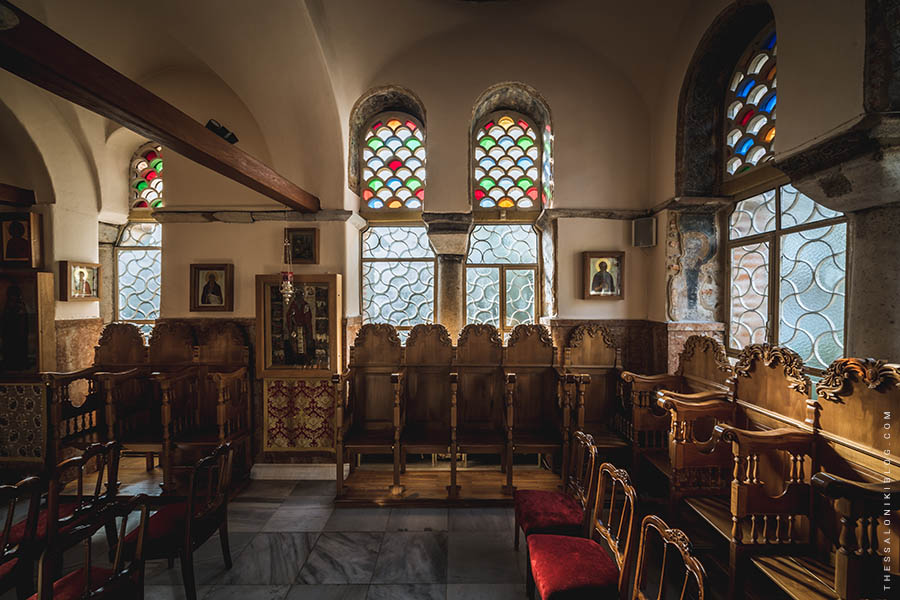
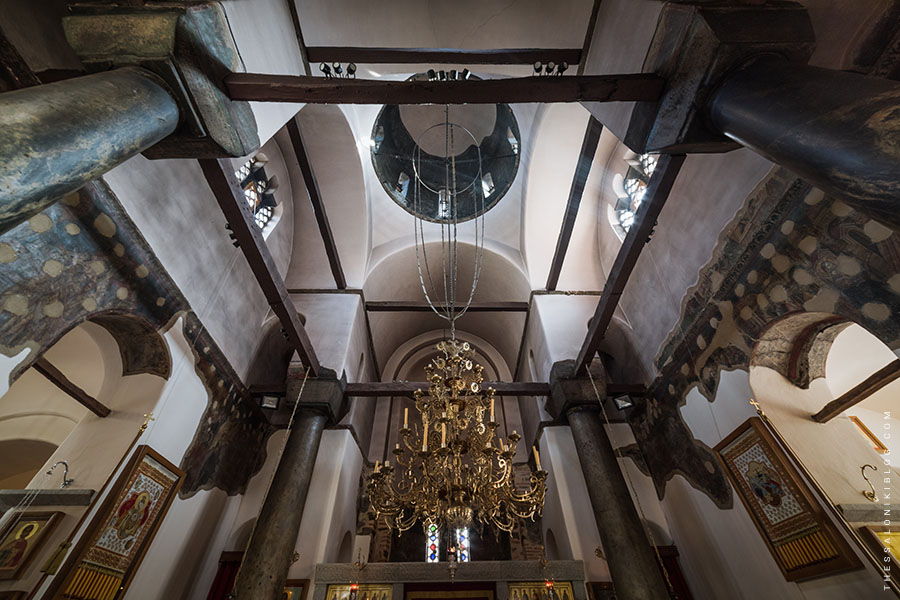
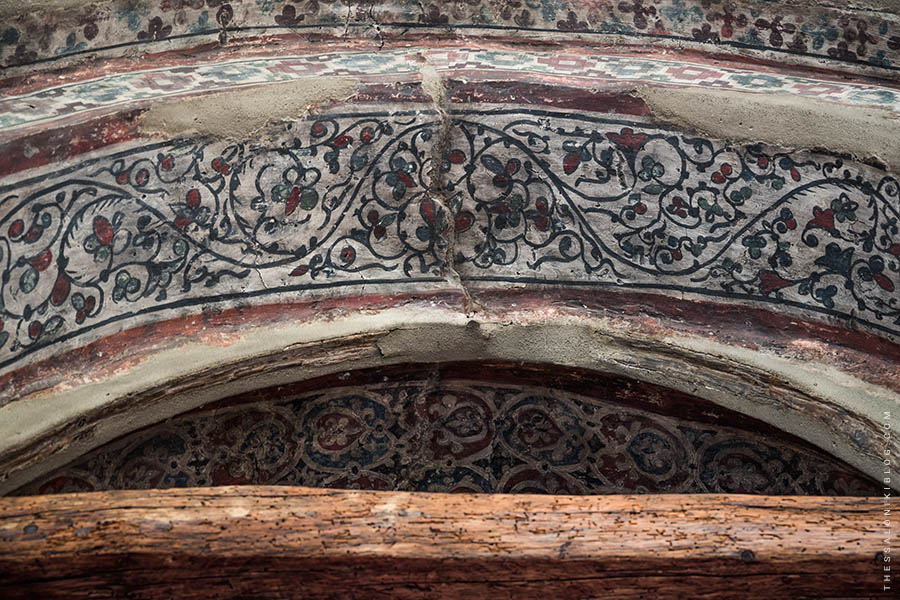
10) CHURCH OF PROFITIS ILIAS (PROPHET ELIAS)
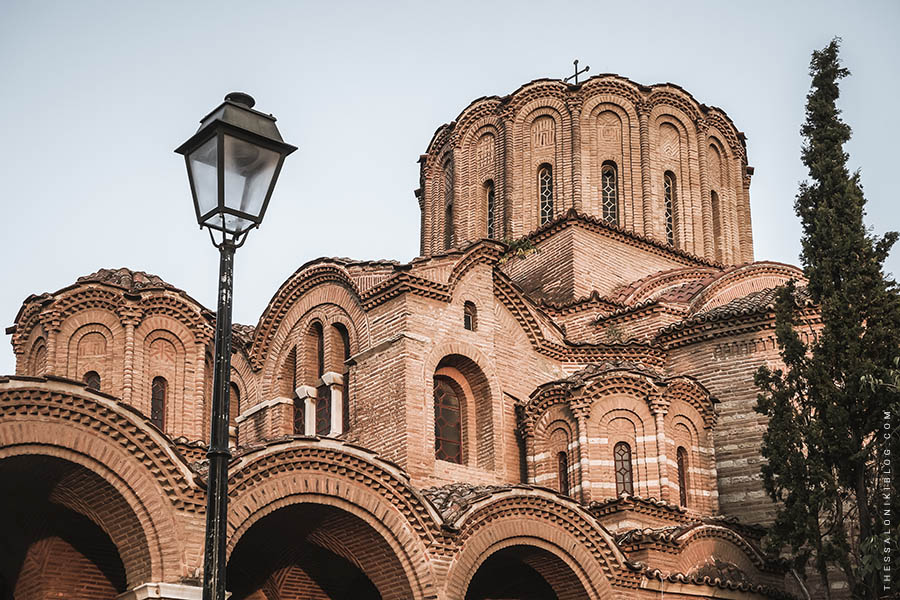
Address: 52 Olimpiados Street (see on Google Maps)
Opening hours: Daily 07:30-12:30 and during the Vespers in the evening
Admission: Free entrance
Phone number: +30 231 027 3790
Address:
52 Olimpiados Street (see on Google Maps)
Opening hours:
Daily 07:30-12:30 and during the Vespers in the evening
Admission:
Free entrance
Phone number:
+30 231 027 3790
The church of Prophet Elias was built in the 14th century and it was the Katholikon of an old Byzantine monastery – probably the Akapniou Monastery, which was associated with the Imperial family of the Palaeologans. It is located on a high point of the city, on Olimpiados Street, which is the southern limit of the Upper Town. Its plan was based on the tetrastyle, cross-in-square type with side choruses, also known as the Athonite type because it was mostly used in the monasteries of Mount Athos. Over the narthex, there is a room overlooking the nave, which probably had an imperial use.
Prophet Elias is one of the most characteristic examples of Palaeologan architecture and one of the largest Byzantine churches that were part of a monastery. Its original name is unknown. However, based on its wall-paintings, it was most likely dedicated to Christ. Following the conquest of Thessaloniki by the Ottomans in 1430, it was converted into a mosque with the name Sarayli Camii (Palace Mosque). Its current name was given to the church after it was restored to Christian faith in 1912 (possibly a misinterpretation of “Sarayli” which sounds like Saint Elias in Greek).
Even though the quality in the design of the church is characteristic of the Palaeologan period, the use of mud instead of mortar in its construction resulted in a structure of low durability. During the Ottoman period, buttresses were added to support the building, saving it from collapsing. The church underwent restoration works between the years 1956-61, during which the exterior peristyle, the domes of the narthex and the chapels at the west side were reconstructed. At the same time, the many Ottoman additions around the original structure were removed. Externally the church is decorated with rows of brickwork patterns alternated with rows of white stone – a motif that was common in the Byzantine churches of Constantinople, unique however in Thessaloniki.
After the Ottoman period, only a few wall-paintings survived. They are dated from the second half of the 14th century and they stand out mostly for their details, which differentiate them from other wall-paintings of the time. Most of them are located in the narthex. Fragments of them can also be found in the nave, in the chapels and on the exterior wall at the west side of the church.
How to get there:
To get to the Prophet Elias from our itinerary’s previous stop, the church of Agia Aikaterini, walk along the south side of the church on Ious Street and turn right on Tsamadou Street. Walk down until you reach Olimpiados Street and turn left on Olimpiados Street. Walk south-east on Olimpiados for 400m and you will see the church on your right. To get there by public transport, take bus 22 until “Athonos” or “Theofilou” bus-stops and walk down until Olimpiados street. To see the exact bus routes and bus-stops, visit the web page of OASTH.
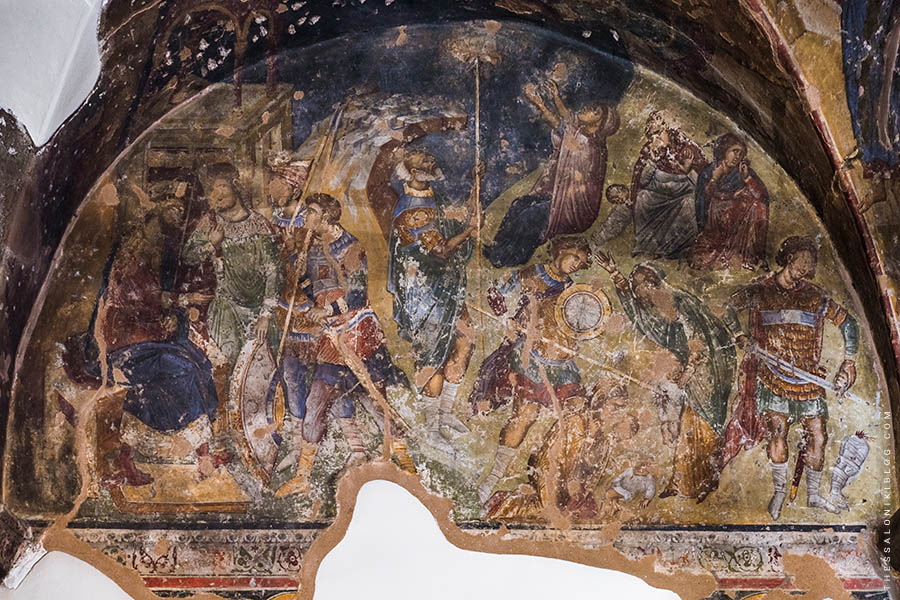
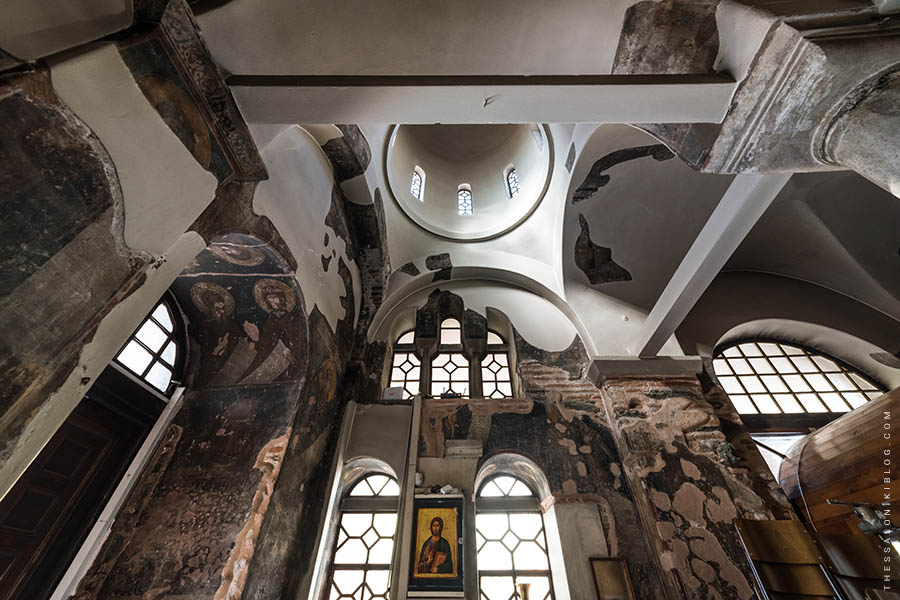
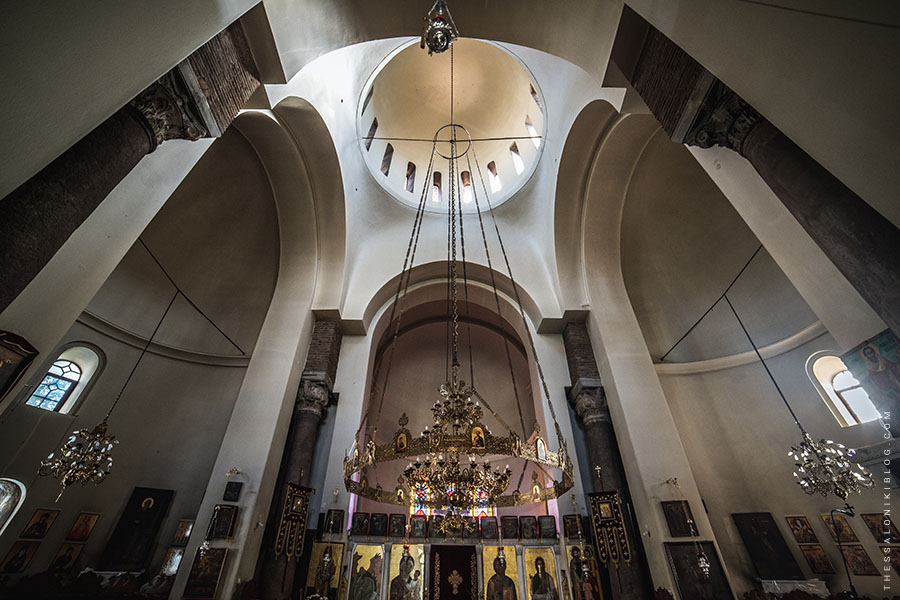
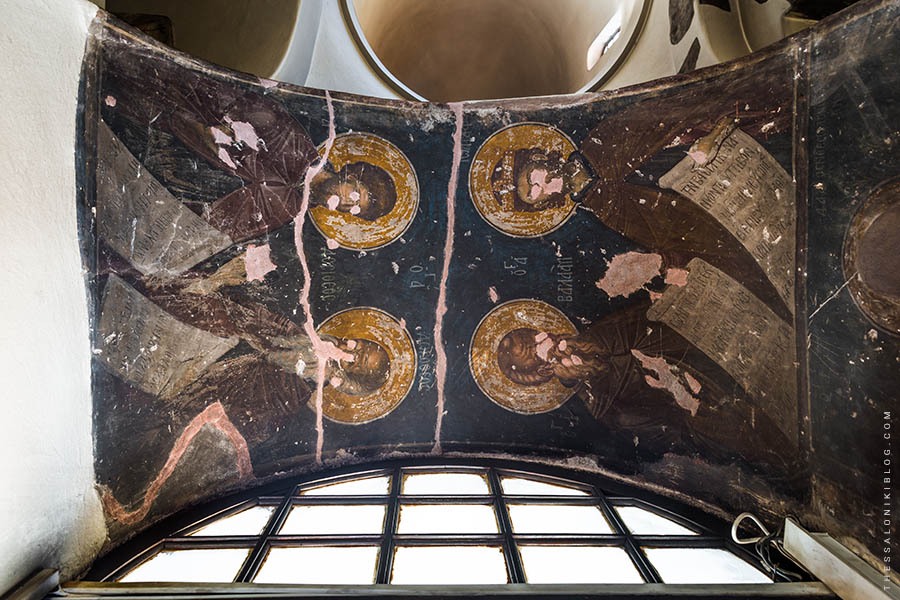
11) THE BYZANTINE BATH
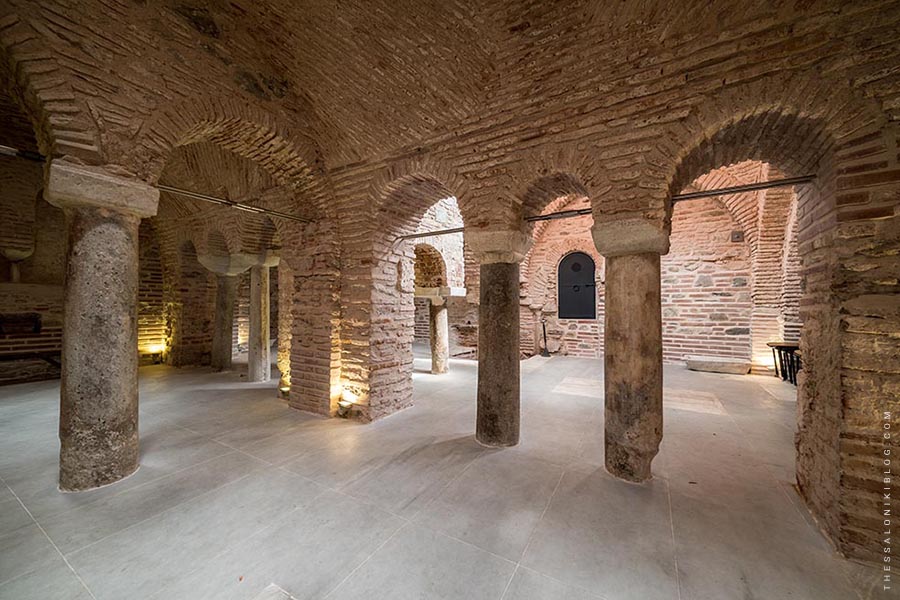
Address: 13 Theotokopoulou Street, Upper Town (see on Google Maps)
Opening hours: Tuesdays, Wednesdays & Fridays: 10:00-13:00
Admission: Free entrance
Phone number: +30 231 020 4868, +30 231 020 9545, +30 231 331 0400
Address:
13 Theotokopoulou Street, Upper Town
(see on Google Maps)
Opening hours:
Tuesdays, Wednesdays & Fridays: 10:00-13:00
Admission:
Free entrance
Phone number:
+30 231 020 4868, +30 231 020 9545, +30 231 331 0400
The Byzantine Bath of Thessaloniki was built around the year 1200 or 1300, and it was functioning constantly until the 1940s. It is the only bath that survived among the numerous that Thessaloniki used to have during the Byzantine period, and the only secular Byzantine building of the city that was saved. Throughout Greece, it is one of the most complete and well preserved baths among the very few that still exist from that era. It is located in the Upper Town, cramped between two tall apartment buildings that were constructed in the 1960s (a testimony to the lack of awareness, regarding the protection of the cultural legacy of the city).
The first room of the bath was the cold section (the equivalent “frigidarium” of the Roman baths), which was used as an entrane hall and dressing room. Then, it followed the warm section (the “tepidarium”) with two barrel vaulted rooms and, finally, the hot section (the “caldarium”), consisting of two domed rooms. The main dome has eight regular arched windows, while on the smaller dome and the vaults there are smaller, round, port-hole windows. The bath was heated under the floor by a low-height, underground level in which hot air was circulating among small columns that were supporting the floor above (hypocaust). For bathing, there were individual tubs.
During the Ottoman period the bath was called Kule Hammam and it was divided in two separate sections for men and women. The building was open again to the public in 2015, only for visiting, after restoration and reinforcement works that lasted for four years. The restoration saved the building from collapsing that was probably about to happen due to its decline by decades of abandonment and the damages caused by the earthquake of 1978. It occasionally hosts cultural events.
How to get there:
To get to the Byzantine Bath from the church of Prophet Elias, walk south-east for 400 meters along Olimpiados Street. At the junction with Theotokopoulou Street turn left and walk for another 50m. To get there by public transport, take bus 23 or 50 until “Koule Kafe” bus-stop, or bus 22 until “Diefthinsi Politismou” bus-stop. To see the exact bus routes and bus-stops, visit the web page of OASTH.
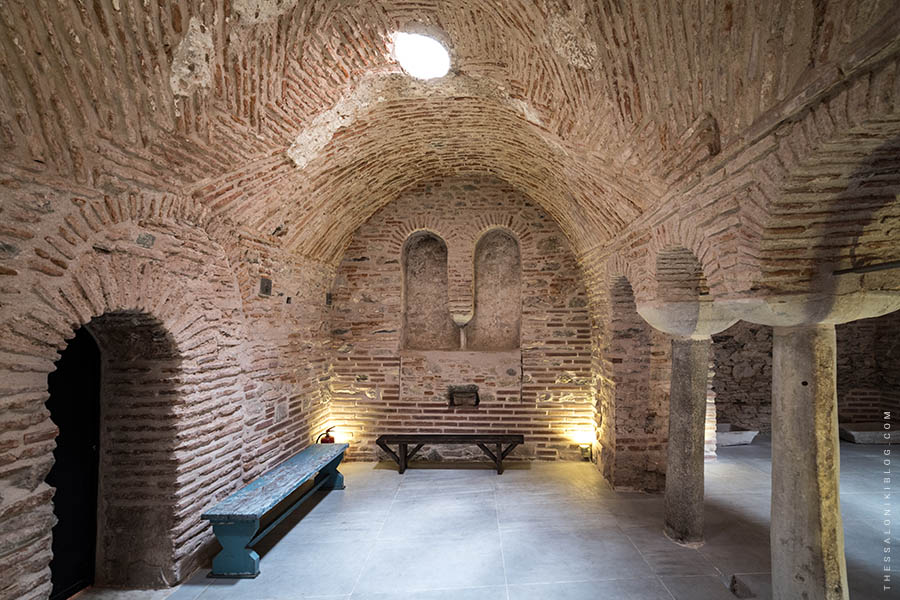
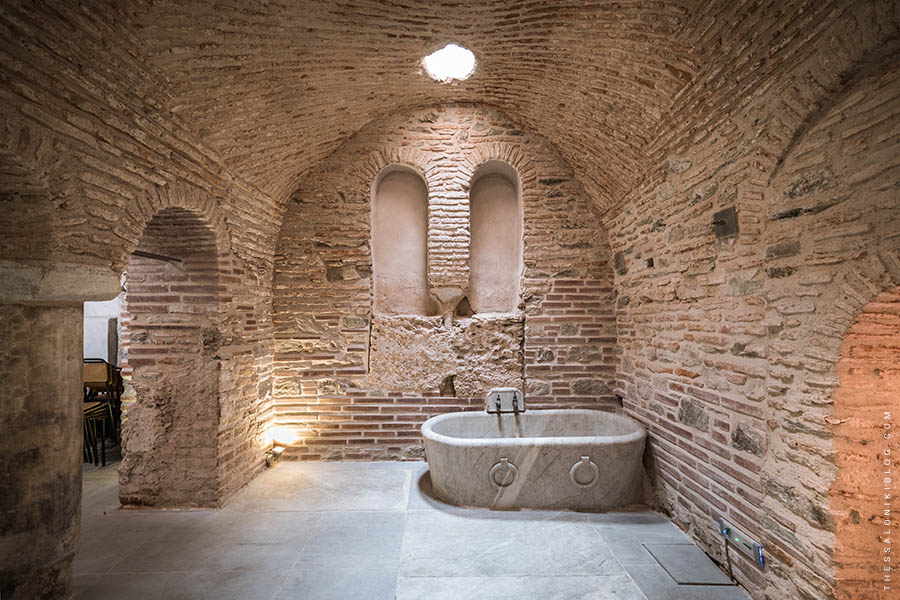
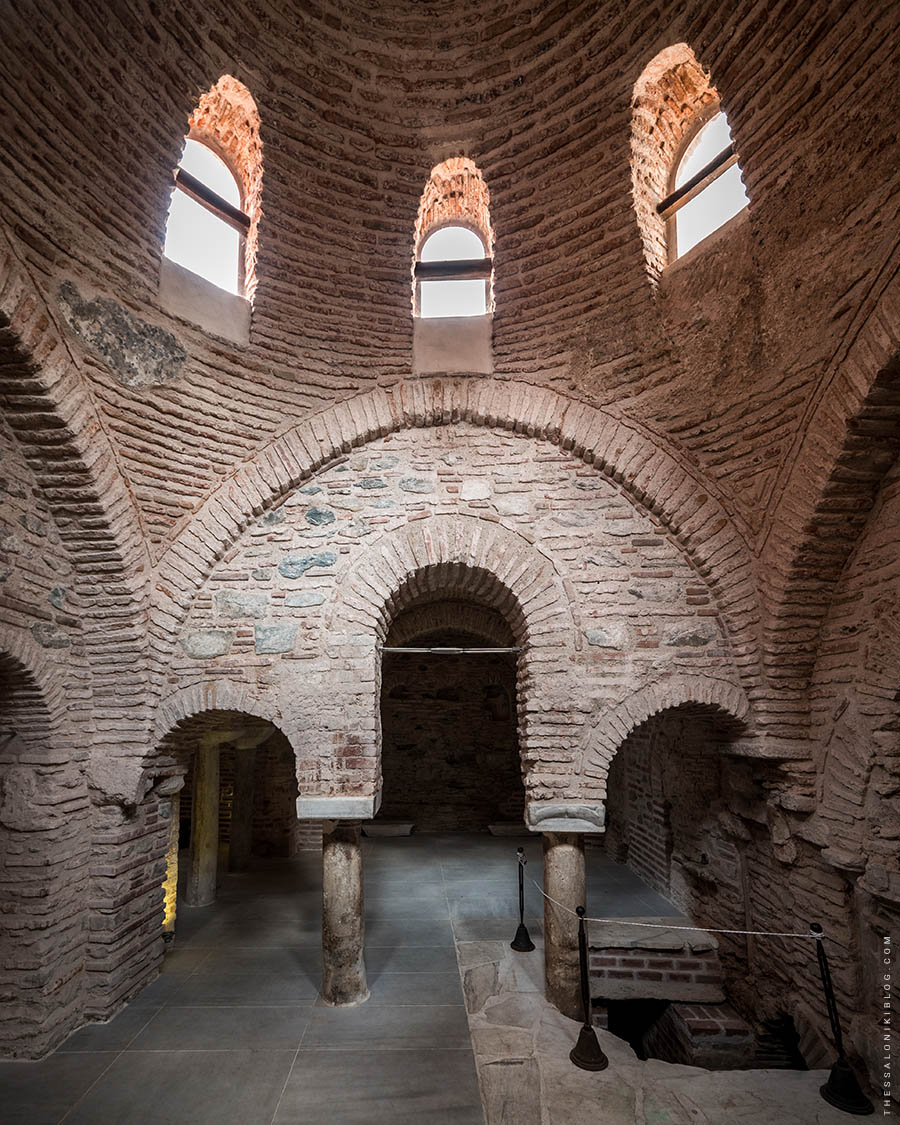
12) CHURCH OF OSIOS DAVID (LATOMOU MONASTERY)
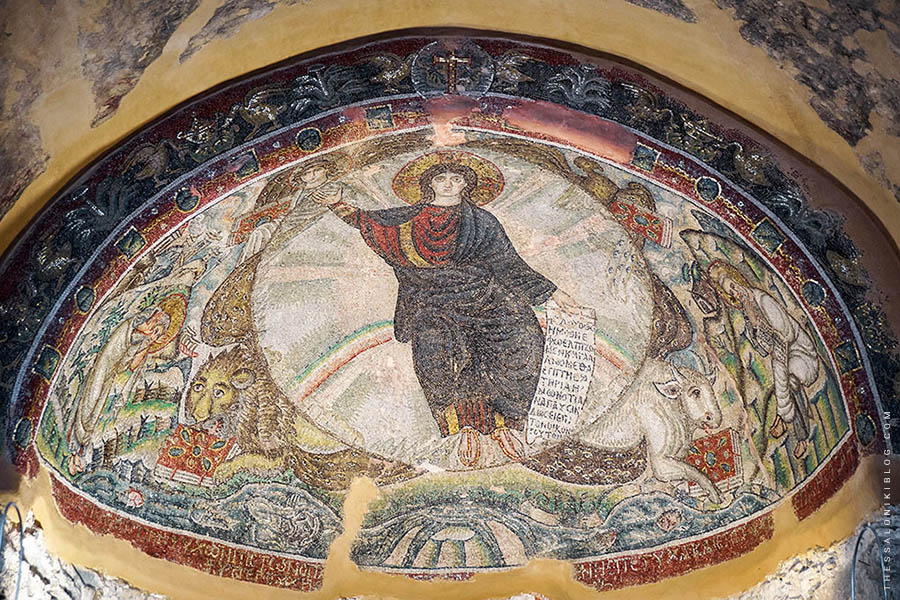
Address: Unnamed alley in Upper Town between Epimenidou, Fotiou and Mpoumpoulinas Streets (see on Google Maps)
Opening hours: Monday to Friday: 09:00-16:00, Saturdays: 09:00-15:00, Sundays: 07:00-13:00
Admission: Free entrance
Phone number: +30 231 022 0020
Address:
Unnamed alley in Upper Town between Epimenidou, Fotiou and Mpoumpoulinas Streets
(see on Google Maps)
Opening hours:
Monday to Friday: 09:00-16:00
Saturdays: 09:00-15:00
Sundays: 07:00-13:00
Admission:
Free entrance
Phone number:
+30 231 022 0020
The church of Osios David was built in the late 5th century and during the Byzantine Period, it was the Katholikon of Latomou Monastery. The name of the latter was probably related to an adjacent quarry (“latomos” is the Greek word for “quarryman”), while the current name of the Katholikon, “Osios David”, was given after the church returned to Christian worship in 1921. It was originally dedicated to prophet Zacharias or to Christ the Savior until it was converted into a mosque in 1430 or later in the 16th century. It is the only building of the monastery that survived.
The church is one of the oldest in Thessaloniki and one of the first in Europe that was built with a cruciform plan in the shape of a Greek cross inscribed in a square (what was later to be known as the “cross-in-square” type). At the four corners, between the arms of the cross, there were four square chambers and at the east arm, the apse of the sanctuary. Above the center of the cross, there was originally a dome that it has not been saved. The whole west part of the church, which was consisting of the west arm of the cross and two of the corner chambers, is also missing. North-west of the building, where one of the corner chambers used to be, there are the remains of the minaret that was built when it was used as a mosque.
Osios David is mostly known for its brilliant Early Christian mosaic on the apse of the sanctuary, dated from the late 5th century – one of the few and most well-preserved mosaics from that period. It is depicting the scene of a Theophany with the rare, youthful and unbearded figure of Christ, sitting on a rainbow inside a glory while holding a scroll with an inscription in Greek referring to the Salvation of mankind. Around the glory, the figures of a man, an eagle, a lion and an ox, each one of them holding a gospel, are impersonating the four evangelists. On the left corner, there is the figure of prophet Ezekiel and on the right corner, the figure of prophet Habakkuk (the scene of the mosaic was probably inspired by their visions – however, according to another interpretation, they could be the figures of Saint Peter and Saint Paul). Finally, at the bottom of the scene, there is a river (probably Jordan or Chobar) feeding on from four rivers of paradise. Inside its waters, there are a few fish and the figure of an old man as the personification of the river itself.
During the iconoclastic period, the mosaic was covered, probably by the monks of the monastery, so that it wouldn’t be destroyed. It was revealed in the 9th century after iconolatry prevailed. During the Ottoman period, the mosaic was again covered in plaster and it was discovered in the 1920s after Osios David became again a Christian church in 1921.
More recently, there have been also discovered under plaster important wall-paintings located on the south vault, above the entrance, and on the east wall of the north arm of the inscribed cross. The wall-paintings are dated to the 12th century (Komnenian Period) and to the late 13th and early 14th century (Palaeologan Period), respectively.
How to get there:
The church of Osios David is hidden among the narrow streets and alleys of a quiet neighborhood in the Upper Town (Ano Poli). To get to Osios David from the Byzantine Bath, follow the map at the beginning of the article. To reach the area by public transport, take bus 22 and get off at “Osios David” bus-stop. Then walk down Mpoumpoulinas Street, turn left at Kassiani Street and walk up until you find the west entrance to the courtyard at the dead-end. Alternatively, get off at “Theofilou” bus-stop. Then walk up on Epimenidou Street until number 21 and follow the alley on your left that will lead you to the east entrance. If for some reason one of the entrances is closed during the opening hours, walk around to find the other one.
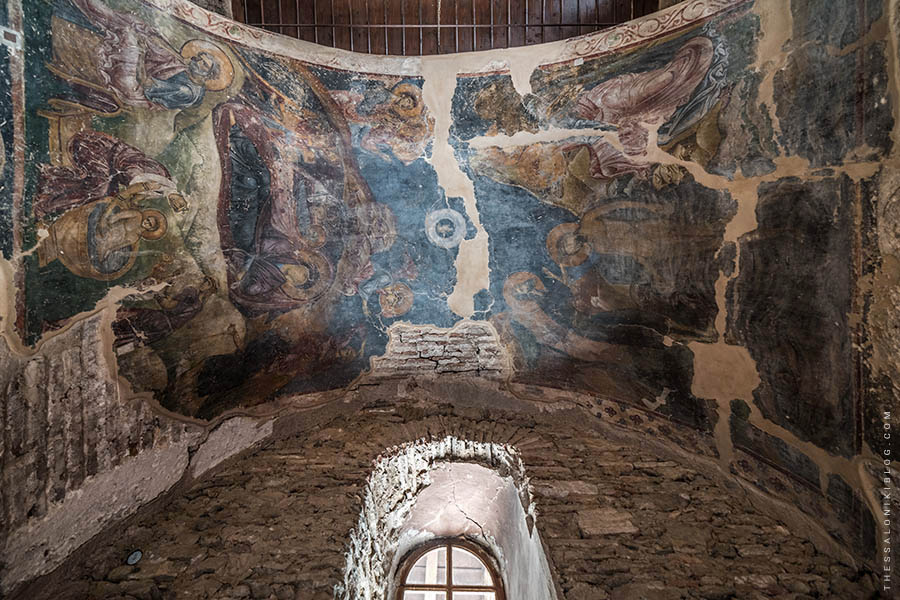
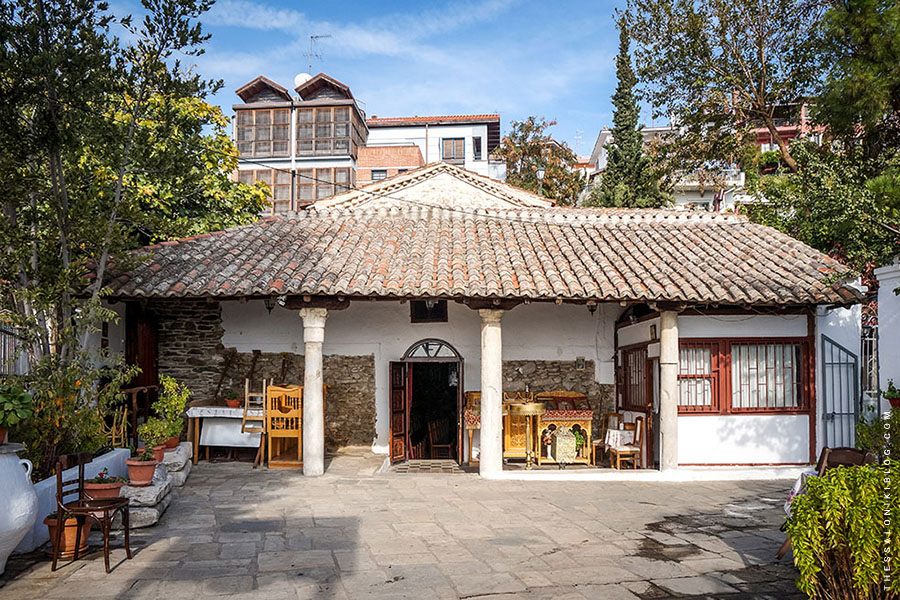
13) CHURCH OF AGIOS NIKOLAOS ORFANOS (ST NICHOLAS ORPHANOS)
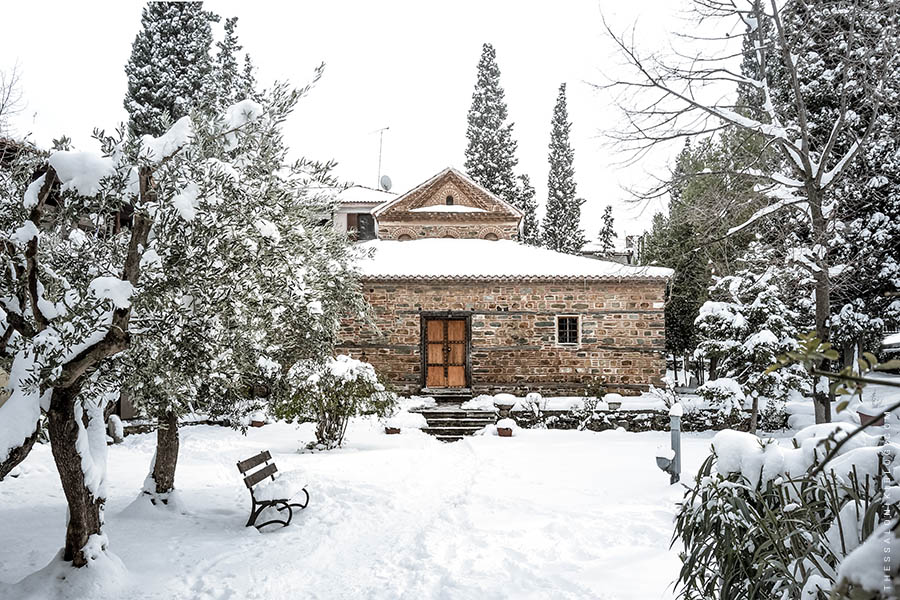
Address: 20 Irodotou Street, Upper Town (see on Google Maps)
Opening hours: Wednesday to Monday: 08:30-15:30, Tuesdays: Closed
Admission: Free entrance
Phone number: +30 231 020 4868
Address:
20 Irodotou Street, Upper Town
(see on Google Maps)
Opening hours:
Wednesday to Monday: 08:30-15:30
Tuesdays: Closed
Admission:
Free entrance
Phone number:
+30 231 020 4868
The church of Agios Nikolaos Orfanos, was built in the early 14th century, and it was the main place of worship (Katholikon) of an old monastery. Apart from the church, the only remainings of the monastery that have been found, are the columns of its old main gate (propylon) located close to the current main entrance to its courtyard. Agios Nikolaos (Saint Nicholas) was considered the protector of the widows and the orphans and this is probably the reason for the name of the church (according to another theory the name could be related to the unknown founder of the church).
The church consists of a main, rectangular core – which contains the nave and the sanctuary – and an ambulatory around its three sides, ending in two interior chapels left and right of the sanctuary. The volume of the core, which is higher than the ambulatory, is covered with a wooden couple-roof while the lower volume of the ambulatory is covered with a lean-to-roof. The masonry of the church is made of stone, bricks, and wood. There are a few decorative brickwork details at the exterior, located mostly at the top of the core volume. The sculptural decoration of the interior consists of two reused marble capitals dated from the Early Christian Period and the marble iconostasis which was created at the same time when the church was built.
The wall-paintings in the interior, dated between the years 1310-1320, constitute one of the rare examples among the Byzantine churches of Thessaloniki, in which almost the entire artwork has been preserved as a whole. They are the work of a painter that belonged to the artistic circles of Thessaloniki, and they are considered exceptional examples of the Palaeologan Art.
The church was probably sponsored by the Serbian ruler Milutin (a deduction based on the influence that the ruler had in the city and on the two figures in the wall-paintings of the nave, depicting Saint George Gorgos, regarded as the protector of the Milutin family, and Saint Clemens of Ohrid, a popular saint for the Serbian people). The monastery of the church continued to function during the whole Ottoman Period, as a metochion of the Vlatadon Monastery. However, its wall-paintings had been covered with plaster (they were uncovered in 1957-1960, during restoration works). Today, the church of Agios Nikolaos Orphanos belongs to the Ecumenical Patriarchate of Constantinople.
How to get there:
The walking route from the church of Osios David to the church of Agios Nikolaos Orfanos passes through some of the most picturesque streets of Upper Town. Since the route is a bit complicated, we advise you to follow the map at the beginning of the article. To reach Agios Nikolaos Orfanos by public transport, take bus 22 until “Platia Kalitheas”, “Irodotou” or “Agios Nikolaos Orfanos” bus-stops. To see the exact bus routes and bus-stops, visit the web page of OASTH.
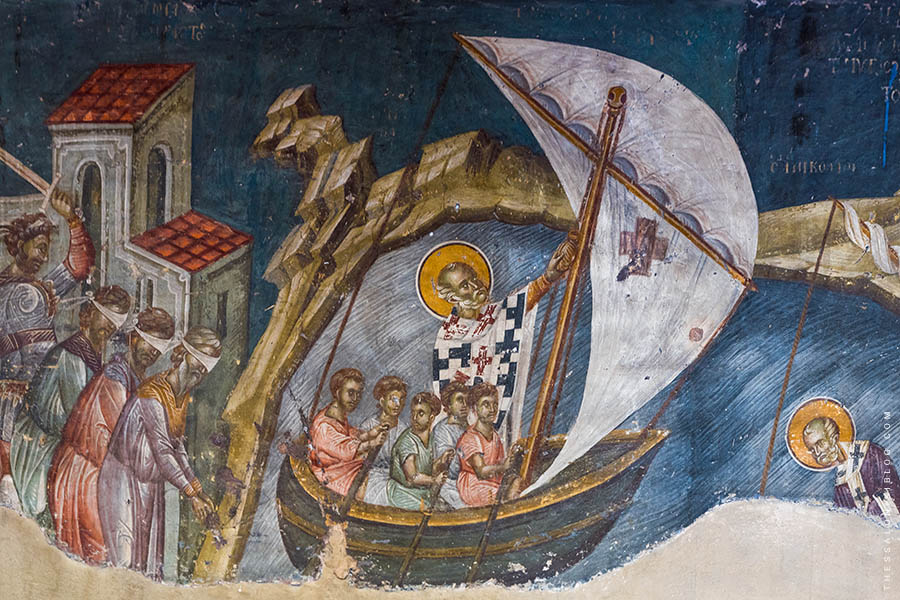
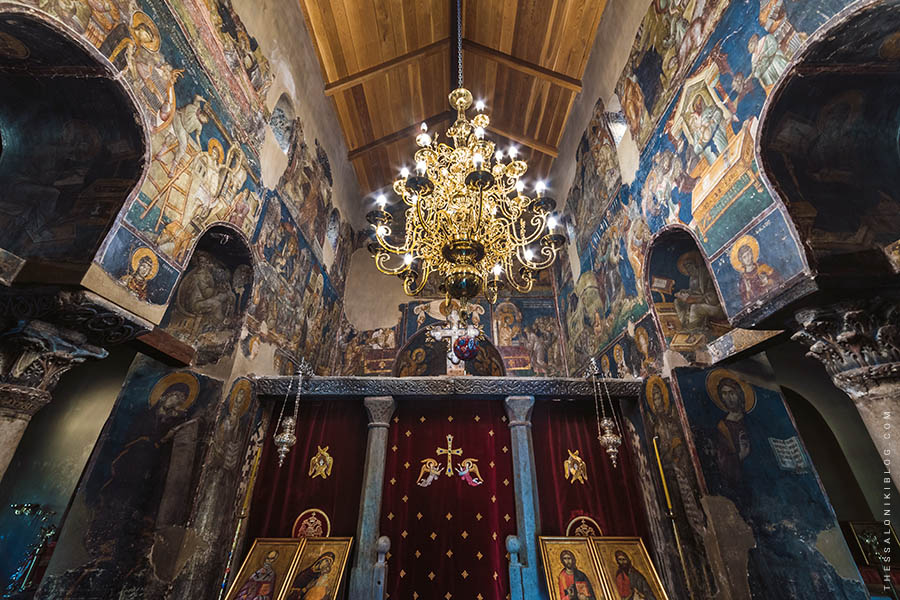
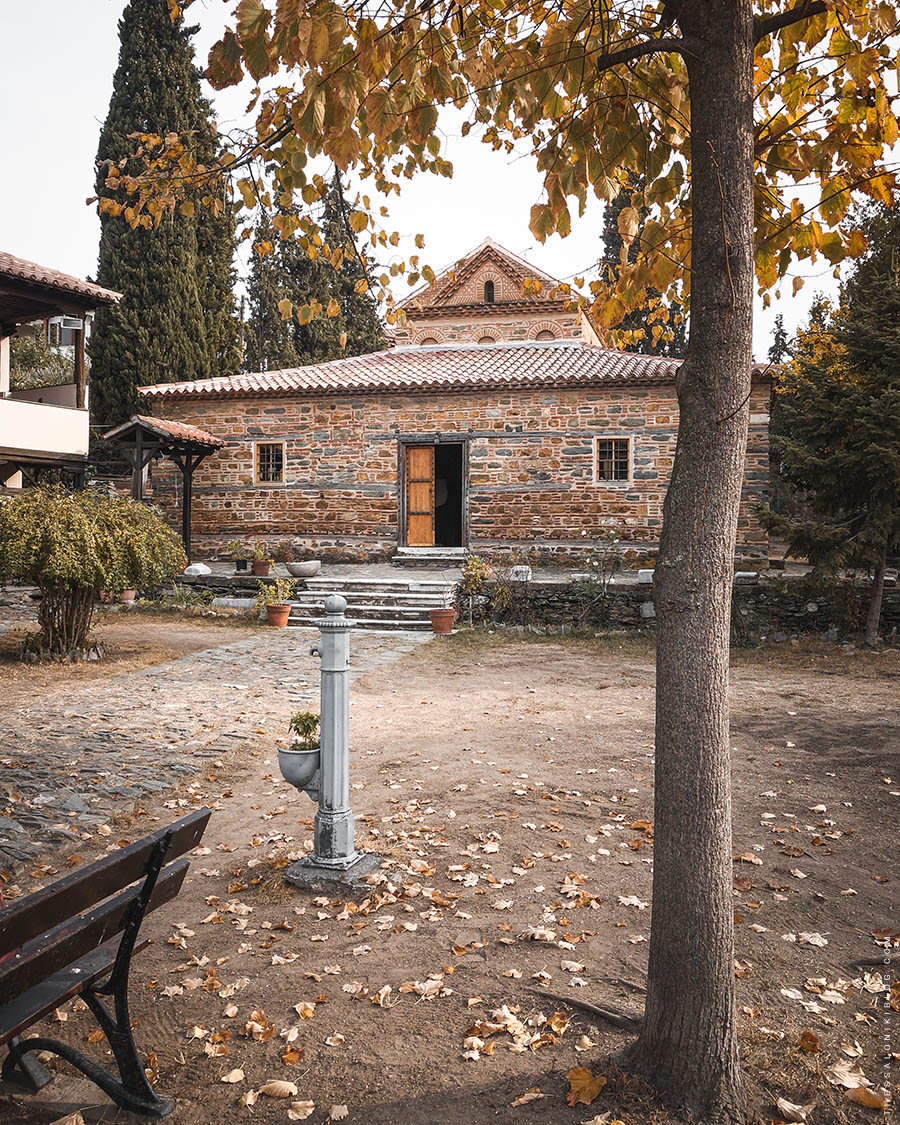
14) THE BYZANTINE WALLS AND THE HEPTAPYRGION
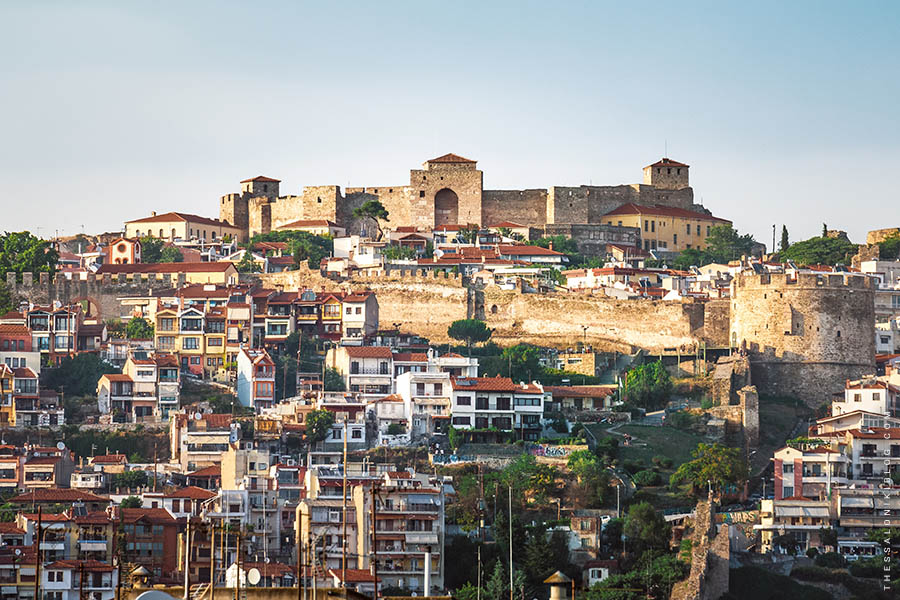
Address: 7 Dimitriou Tzachila Street (Heptapyrgion) (see on Google Maps)
Opening hours: Wednesday to Monday: 08:30-15:30 (the towers and the pathways on the walls close at 15:00) – Tuesdays: Closed
Admission: 3€
Phone number: +30 231 331 0400
Address:
7 Dimitriou Tzachila Street (Heptapyrgion)
(see on Google Maps)
Opening hours:
Wednesday to Monday: 08:30-15:30
The towers and the pathways on the walls close at 15:00
Tuesdays: Closed
Admission:
3€
Phone number:
+30 231 331 0400
The first walls of Thessaloniki were constructed during the Hellenistic Period, after the foundation of the city by King Cassander in 316/315 BC (probably in the 3rd century BC). However, during the Roman Period of the city and the years of Pax Romana, they became obsolete, and by the middle of the 1st century AD, they were in ruins.
The second walls of Thessaloniki were constructed for the protection of the city by the raids of the Goths in the 3rd century AD. Even though they effectively fulfilled their purpose, they had been built in a rushed manner, incorporating ruins of old buildings and in the late 4th century (Early Byzantine years), during the reign of Theodosius I, they were replaced by a stronger and most permanent structure. The new walls were constructed with the late Roman mixed technique of ashlar masonry alternating with rows of bricks.
These are the walls that have survived until today, including many of the later additions and repairs that were made for the improvement of the fortification of the city throughout the entire Byzantine and Ottoman Periods. In their completion, they were approximately 8km-long and 10-12 meters high. Today, after the Ottomans demolished the walls along the sea and the southern parts of the west and the east wall in the late 19th century (in order to expedite the growth of the city), they are about 4km-long.
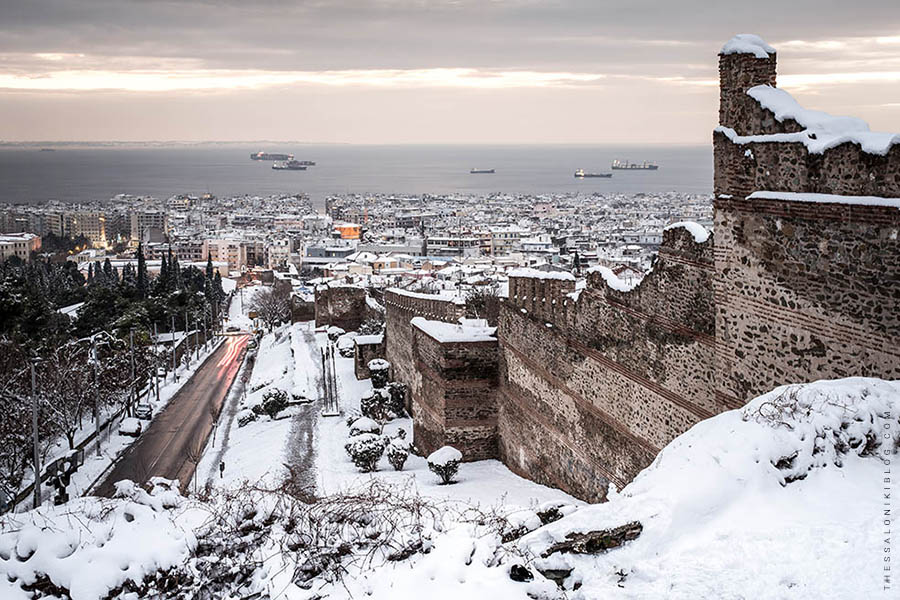
Along the walls, there were several fortification towers, fortresses, gates and triangular bulwarks at frequent intervals. The walls of the Acropolis in the north were added at a later time than the main walls of the city. The Acropolis was kept separated from the rest of the city by the previous outer northern part of the walls. Inside the Acropolis, at the highest point of the city, there is still standing the most impressive building of the fortifications: the Heptapyrgion Fortress, also known during the Ottoman Period as Yedi Kule.
Both its Greek name (Heptapyrgion) and its Turkish name (Yedi Kule) mean “seven towers”, however, the fortress had ten. The five northern towers and the wall connecting them are dated to the late 4th or to the 9th century and they were part of the Acropolis walls. The fortress practically was created when the south five towers and their connecting wall were constructed probably in the 12th century. Parts of the fortress were repaired and others were rebuilt during the Palaeologan period. The central tower at the main entrance was repaired or rebuilt shortly after the Ottomans conquered the city in 1430. The fortress underwent another restoration in the 17th century. In the decade of 1890, it was converted into a prison and it retained that function even under Greek administration until 1989 (!). It was probably the most notorious prison in Greece. During those times several new buildings were added inside and outside of its surrounding wall. Today the monument is hosting Thessaloniki’s Ephorate of Antiquities and several cultural events are taking place in its facilities.
Besides the Heptapyrgion, among the large fortification works that have been saved are two (2) of the cylindrical towers that were constructed during the Ottoman period: the White Tower, which became the symbol of the city, and the Chain or Alysseos Tower, both replacing older structures. The Chain Tower stands at the point from which the Ottomans managed to enter the city in 1430. It replaced the old Byzantine Trigonion Tower which was located at the same or on an adjacent location. Across the Vlatadon Monastery, there are also the remainings of the square tower of Lapardas. The Vardaris Fort, at the intersection of the west wall and the seafront wall – constructed also by the Ottomans – has not been saved.
The gates of the walls that exist today had mostly secondary functions. They are located at the north and the medium wall, including the Anna Palaeologina Gate in the southeast of the Acropolis. The main gates of Thessaloniki have been demolished. They were located at the west and the east walls, on the axes of the two main roads of the city: the Byzantine “Leoforos” (meaning “avenue”), located along today’s Egnatias Street and the second main road of Byzantine Thessaloniki along today’s Agiou Dimitriou Street. At the west wall, there was the Golden Gate on the axis of the Leoforos and the Letaia Gate on Agiou Dimitriou Street. At the east wall, on the same axes, there were the Cassander’s Gate and the New Golden Gate respectively. Additionally, at the east wall, there was the Gate of Rome close to the White Tower and the Gate of Asomatoi towards the north of the city.
How to get there:
To walk from the church of Agios Nikolaos Orphanos to Heptapyrgion, we recommend that you follow the city walls as we are showing on our map at the beginning of the article. The total distance is 1.3km, however, along the route, you will find a lot of places to stop and admire the city as you move up, or you can seat at one of the many restaurants and cafes of the area. To get to Heptapyrgion by public transport, you can take bus 23 or bus 50 until “Eptapirgiou” bus-stop.
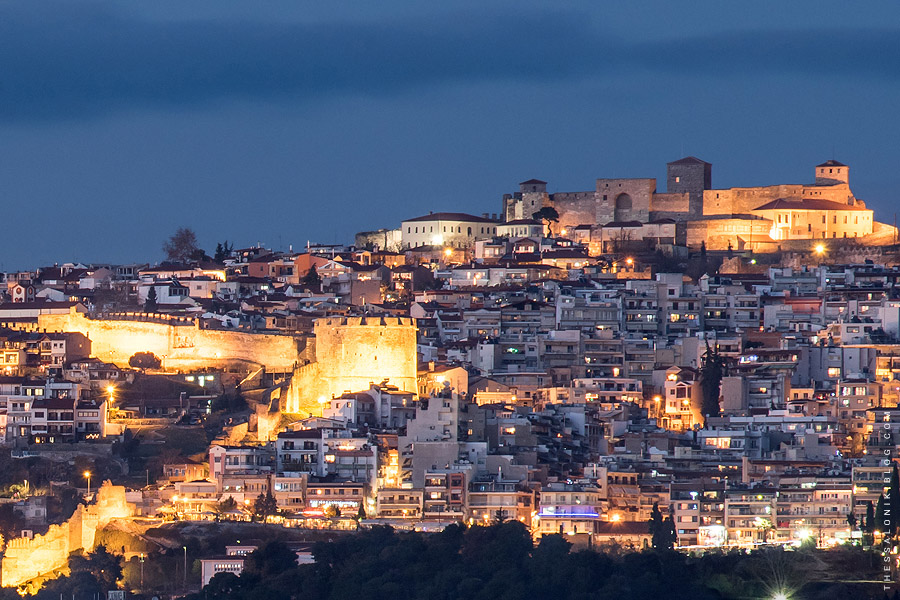
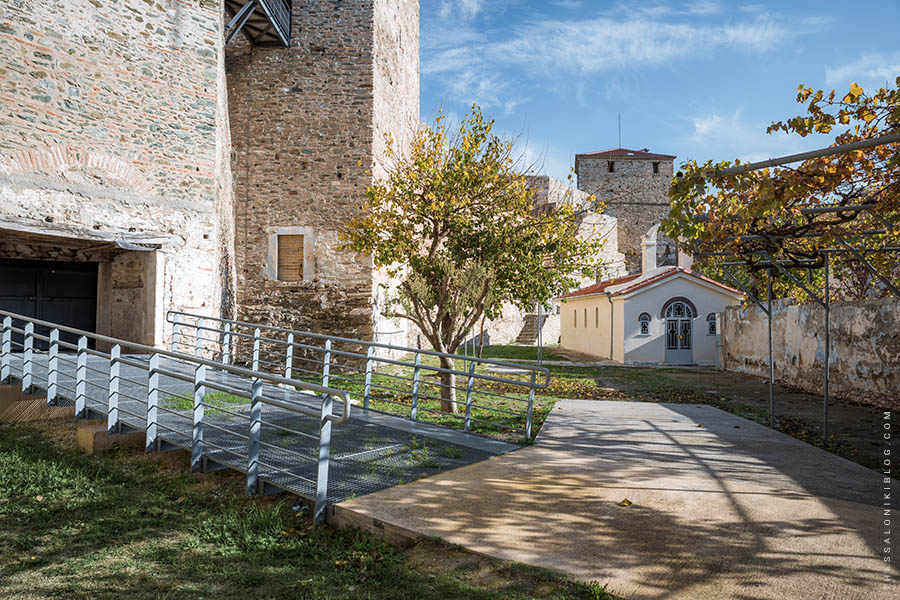
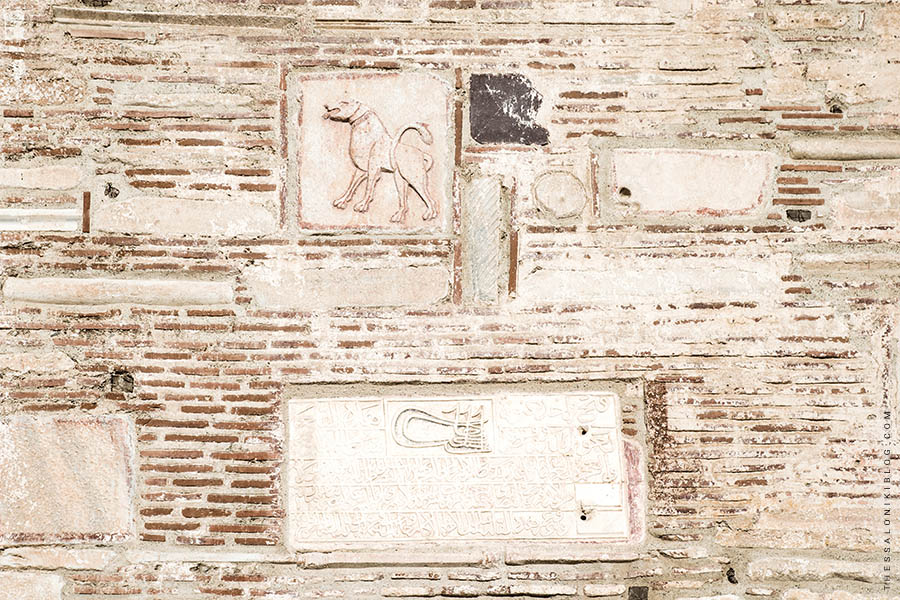
15) KATHOLIKON OF VLATADON MONASTERY
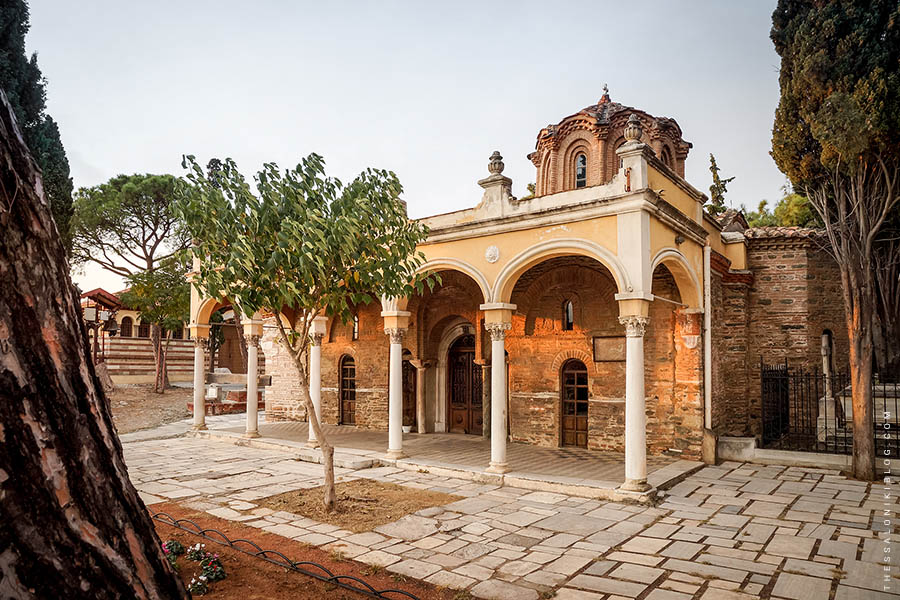
Address: 64 Eptapirgiou Street, Upper Town (see on Google Maps)
Opening hours: Daily 07:30-13:00 and 18:00-20:00 (the courtyard is open 07:30-20:00)
Admission: Free entrance
Phone number: +30 231 020 9913
Address:
64 Eptapirgiou Street, Upper Town
(see on Google Maps)
Opening hours:
Daily 07:30-13:00 and 18:00-20:00
(the courtyard is open 07:30-20:00)
Admission:
Free entrance
Phone number:
+30 231 020 9913
The Katholikon of Vlatadon Monastery was built in the middle of the 14th century, during the late Byzantine period. Although it was initially dedicated to “Christ Pantokrator” today it is dedicated to the “Transfiguration of the Savior”. It is the only preserved Byzantine edifice of the old monastery. According to tradition, around the years 50/51 AD, Paul the Apostle preached at the same place where the church is built. Archaeological findings indicate that at the same place there was probably an older temple.
The plan of the church is based on the cross-in-square type with a dome and an ambulatory which ends in two interior chapels left and right of the sanctuary. The dome instead of being supported on columns, like in most cross-in-square churches, is being supported on the wall of the sanctuary and on two pillars at the west (probably because it was built on parts of the older temple that was standing on the site). Although there have been made later additions and repairs (mostly at the ambulatory and the north chapel), the Katholikon retains many of its original architectural elements. At the exterior, there is also a colonnade at the south side and a small porch at the west main entrance (both of them later additions).
The frescoes of the Katholikon are fine examples of Palaeologan Art and they still retain their vivid colors although they have been extensively damaged. After the first, temporary Ottoman occupation of Thessaloniki in 1387, the monastery was sequestered and the church was converted into a mosque. During the conversion, the frescoes were hammered, so that they could be effectively covered with plaster.
After the second and final occupation of the city in 1430, the monastery remained autonomous and had many privileges. Probably, the reason for that was that in the meantime the monastery had been proclaimed patriarchal and was no longer royal (and therefore was not an official enemy of the Ottoman Empire). However, according to tradition, this special treatment was gained due to the help that the monks gave to the Ottomans during the siege of the city.
The Katholikon, together with the rest of the monastery’s buildings (constructed in the late ’60s and onwards), form a big complex that is located close to the Acropolis Walls in the Upper Town (Ano Poli). It is the only monastery since the Byzantine period that is still active and it belongs to the Ecumenical Patriarchate of Constantinople.
The entire area is really worth to be visited, not only for the church itself and its wonderful wall-paintings but also for the beautiful courtyard with panoramic views to the city and for the museum and sacristy of the monastery with treasures, icons, and manuscripts (not always open for visitors). Also, in two separate enclosed areas of the complex, are kept domestic and wild(!) animals and birds (deers, sheep, peacocks, and white peacocks).
How to get there:
To walk from Heptapyrgion until the Vlatadon Monastery, follow the map at the beginning of the article. Be there before sunset to enjoy the wonderful view of the city. To get to Vlatadon Monastery by public transport, take bus 23 or bus 50 until “Platanos” bus-stop. If you take bus 23 after you get off you will have to walk for 80 meters in the opposite direction along the city walls. If you take bus 50 you will have to walk south through the adjacent gate of the walls and then turn right. Alternatively, take bus 22 and get off at “Platia Tsitsani” bus-stop. Take up the stairs to the north and then turn right on Eptapirgiou Street. Walk for 130m and you will see the entrance to the courtyard on your right.
